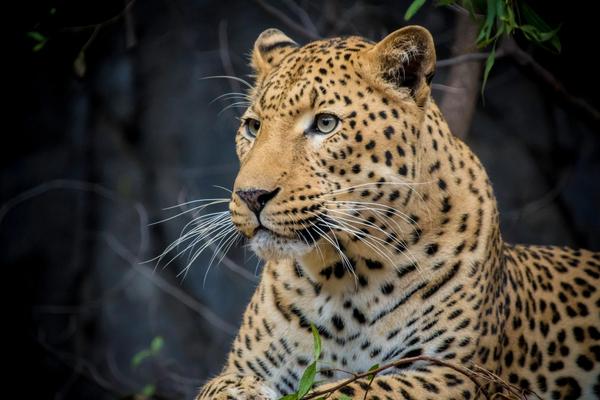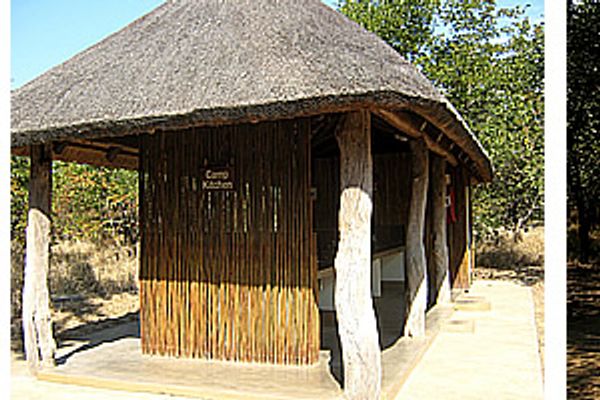
A new camp in Kruger Park
Tzendse Rustic Campsite is the newest camp in the Kruger National Park, opened to the public in late 2006.
Fresh thinking influenced the design and the feel of the camp. It was conceived as a ‘touch the earth lightly’ camp, in line with current practice. The planners thought of this direction as a ‘ back to basics’ one, the one which prevailed in the Park in the beginning, when one could have an immediate and personal experience of the bush. Tsendze, as a result, is completely different to the other camps in the Park.
This was our first visit. Tsendze flies well below the radar. I hadn’t picked up yet that it was a very desirable destination. It is true that one day we passed by, and since the gates were open , we went in and had a look – very impressive. Our next visit to the Kruger was to Tsendze.
We yet knew little about the place
It is not advertised widely. Residents enter the sturdy wooden gates, opening and closing them, as needed. They are designed to keep out elephants. There is no one at the gate to observe your entry or departure. There is no reception desk, no shop, restaurant, filling station or pool – nothing at all, just you and your fellow campers. There are two ablution facilities well within the rings of the camp sites and two beautifully maintained kitchens.
Since this was a brand new experience for us we took the site allocated to us at Mopane, where you check in. We went into Tsendze to look for site 30. We were quite happy. Most of the sites are private, and shaded by ancient and beautiful trees, each site separated by stretches of natural bush and tall yellow grass. There are no planted areas or grassy lawns and every one of the 34 sites at Tsendze is against the fence. One is shielded on all sides, and can sit in complete privacy and contemplate the bush. Directly in front of us was a giant Apple Leaf Tree. The sun moved across the sky, creating patterns of light and shade over the leaves and branches. Yes, we did spend a lot of time in our camping chairs.
I had seen the signs on entering Tsendze
‘This is a low impact noise facility.’ But I wasn’t really clear on what that meant. No electricity – none at all. No electronic beeps and flashes, no generators or lights, no noisy day visitors. Each camp was shrouded in its own circle of gas light at night. Only the flash of the braai fires illuminated the darkness. But still it needed to sink in. Slowly one becomes attuned to the natural sounds of the bush. The impact on one‘s senses is slow to make itself felt. No traffic , loud voices, malls, music, cell phones or TV. It is idyllic.
That evening, I could hear the muffled sound of voices from the closest camp site. But a low base note persisted. ‘Huh-huh’ Huh-huh’, deep and continuous. I am not a birder and had no clue what it was. I thought it sounded like a male voice, complaining about something without let-up. A short while later, the caretaker of the camp, Rodger, and his colleague, Helena, appeared. They introduced themselves and asked if we had heard the call of the giant eagle owl from a nearby camp site.
Allow me my moment
I quote from an article in the Go! Magazine (Oct., 2012) concerning the Kruger camps these days. The writer comments, ‘ I’m surrounded by caravans, mobile homes, and bush trailers bristling with flaps and devices, as if they’re receiving messages from outer space.’
The sound of owls at night, the cry of the fish eagle by day, the rustle of dry grass and leaves, and sometimes the steady progress of something very large moving in the bush, just out of sight, are the sounds one hears. A huge elephant did appear close to the entrance gate one day, and one evening, the near and unexpected roar of a lion. They are definitely there. Though the camp is set within a loop of the Tsendze River, one cannot actually see the river, but animals are attracted to the area.
Rodger calls every morning and evening
He does this to make sure everything is alright, to check that your fire is not too close to the long grass, and to report on the days sightings. The very first evening we were told that the people at camp 16 had seen a leopard that day. Two evenings later the people at camp 23 had the same luck. Some other campers had spotted lion on the S50. There is no sightings board, but everyone goes to bed, as in zipped in a sleeping bag, filled with hope after Rodger has called.
One does follow Kruger time
Up at dawn, sort of, shower at midday and in bed by nine. The showers are another delight – open to the sky- and shaded by a giant Mopane. But if truth be told, the charm of the camp holds one there. One can think of nothing more pressing than to sit in one’s camp chair and enjoy the rare atmosphere. All the way around the perimeter of the camp fence, a metre of grass has been cleared – and many campers take a walk to look for birds or just to take an evening stroll. Hence perfect strangers sometimes appear in front of one, in what is now one’s front room. They frequently stop to chat and exchange news of sightings. A little awkward when one is enjoying an untimely glass of wine or something.
Now for the best news about Tsendze
It is the only camp in Kruger where you can book a specific campsite. Do the usual booking at SAN Parks Central Reservations, then phone Mopane Camp on 013 735 6535/6 and ask for your desired camp site. I did a walkabout and rated no.6, 14, 21, 26, 27 and 28 as being good….mostly because of lovely big trees, or because of the view of the bush. However I heard from Rodger that number 3 is magical. A certain couple had been there for 30 days already, and counting. Once you get there, you can always check with Mopane if you want to change sites.
Now to the business of looking for animals
Most people avoid this northern area, characterised by forests of Mopane, but there are many and unique delights quite close by. The area is not as highly rated as some other camps with regard to animal sightings, but Tsendze Camp received the highest overall rating of any of the camping areas in the whole Kruger Park, in a survey done by Go! Magazine in 2012. Categories included Facilities, Atmosphere, Privacy, Animals and Birds.
There are three main loops to take from the camp
Two prominent seasonal water courses , the Tsendze River and the Nshawu Creek, run through the area. Perhaps for me the most rewarding is the southern route, along the Tsendse River. Take the tar H1-6 south, and then turn right onto the S48. The loop follows the river bed, dry in places, but with deep pool s and streams from time to time. (June). Many sub-loops dip closer to the river, completely obscured by giant trees and natural vegetation. According to the literature, this is the main area to see leopard. But the leopards seen by fellow campers were more to the north, at the hides close to Mopane.
As with any sighting in Kruger, one moment the animals are there, and the next moment they are gone. We hadn’t seen much, when, along a small sub- loop, we spotted a single buffalo emerging from the opposite bank. He was soon followed by many, two and three abreast, and then hundreds, pouring down the bank to drink on the river bed. The sentinels took up their positions, and though we were the only humans there, they didn’t like it. It was touch and go whether they were going to stay or not.
Another much lauded route is the one to the West of the camp, leading to the Tropic of Capricorn Road
Head to the S50, and starting at the beginning, go north along this route. There are four waterholes and the Nshawu Dam to see before you reach the Tropic of Capricorn Road. This is open country, and the map shows it as a marshy. When we visited, the entire area was covered in rolling yellow grass. This is the road to see the big tuskers, and we were not disappointed. I saw three huge elephants moving purposefully but gracefully along the open plain, almost in single file, towards an ancient Leadwood Tree, a surviver of many floodwaters. One stares as if one has seen the image before, so iconic it is – yet new and fresh again in real time.
For those of you not fixated on seeing the predators, this area is famous throughout the Kruger Park for sightings of the rarer antelopes. Tsessebe, Roan and Eland can be seen in this area as well as many of the more common varieties, such as large herds of Zebra.
The Tropic of Capricorn Loop is named as one of the top five roads in the Kruger Park for scenic impact. And indeed, it has a great and undefined charm. Maybe something to do with the open aspect, the elevation of the whole area and the quality of light. Usually there are many antelope to be seen, a variety of species, especially close to the Tihongonyeni waterhole. Don’t miss this drive.
Between Tsendze Camp and Mopane Camp, are some small loops to take off the tar H1-6 road. They are very close to camp, and one evening along one of these short loops, we were surrounded by a huge breeding herd of elephant, making their way down to the water.
All in all, the absence of crowds of people, the undisturbed quality of the natural bush and the authenticity and natural behaviour of the animals makes this a very rewarding area to experience. The area is especially known for large herds of buffalo and big tuskers.
The name Tsendze is the Tsonga word for ‘Tsendzeleka’ or ‘to wander around aimlessly in the bush as if one were lost’. Sounds like the lost art of rambling.
Note: The caretaker is Rodger Hobyane. He is on the Kruger forum as chat/rodgerh. He is a keen birder, and together with Helena, they keep the camping sites absolutely spotless. The kitchen has gas hobs as well as large fridges and freezers for the use of the campers.
Tsendze Rustic Camp Site, a ‘campers-only paradise’.
